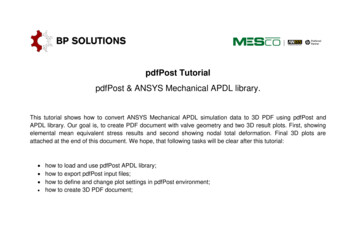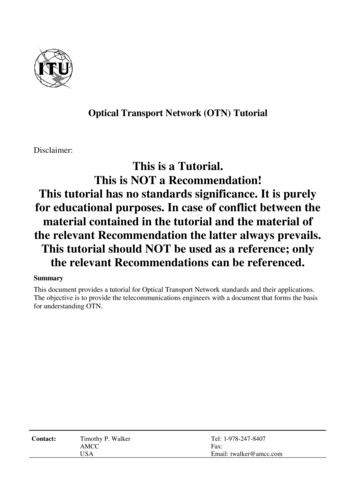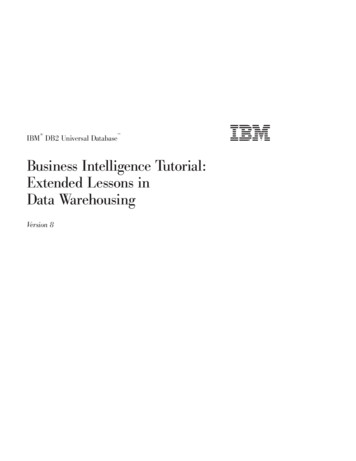
Transcription
pdfPost TutorialpdfPost & ANSYS Mechanical APDL library.This tutorial shows how to convert ANSYS Mechanical APDL simulation data to 3D PDF using pdfPost andAPDL library. Our goal is, to create PDF document with valve geometry and two 3D result plots. First, showingelemental mean equivalent stress results and second showing nodal total deformation. Final 3D plots areattached at the end of this document. We hope, that following tasks will be clear after this tutorial: how to load and use pdfPost APDL library; how to export pdfPost input files; how to define and change plot settings in pdfPost environment; how to create 3D PDF document;
pdfPostTutorials1. First stepsa.b.c.d.Create working directory for this project ex. c:\Valve;Create/copy empty ANSYS database to the project directory;Unzip Tutorial3 Files.zip (valve.cdb, valve.s01, APDLtoPDF.lib) to the project directory;Run ANSYS database and:i. deactivate element shape check - SHPP,OFFii. read CDB file - CDREAD,DB,valve,cdbiii. read load step file - LSREAD,1iv. enter solution processor - /SOLUv. solve model - SOLVE2. Saving geometrya. Create component to export:i. select solid elements - ESEL,S,TYPE,,1,2ii. create component - CM,valve,ELEMiii. in project directory, create text file named "CompL valve.txt". First line of this file should contain name of the component ("valve").In case, there are more components, each component name should be in the file as a separate line;b. load the APDLtoPDF.lib library - *ULIB,APDLtoPDF,libc. initialize library (necessary arrays, tables etc.) - *USE,APDLtoPDF initd. create name for the PDF project - *USE,setProjectName,'valve'e. create default file names based on project name - *USE,setFileNamesf. create pdfPost geometry input files - *USE,saveGeometryg. start XML configuration file and write geometry information:i. *USE,initXMLii. *USE,XmlDocumentiii. *USE,XmlComponentsiv. *USE,XmlETypespdfPost & ANSYS Mechanical for starters2
pdfPostTutorials3. Create and write resultsa. Create ETABLE for exported component:i. enter postprocessor - /POST1ii. ETABLE,SEQV,S,EQVb. Write ETABLE data:i. *USE,writeEtable,'SEQV',-1e8,1e8,'S'c. Write nodal deformation data:i. *USE,writeUNodesd. Set additional plot information and write them to the XML configuration file:i. *SET,pp dScale,80.0ii. *USE,XmlPlote. Write Nodal Averaged data:i. *USE,writeNodalValues,'USUM','U','SUM'f. Set additional plot information and write them to the XML configuration file:i. *SET,pp renderMode,'SolidOutline'ii. *USE,XmlPlotg. Close XML configuration file and clear APDLtoPDF library variables:i. *USE,endXmlii. *USE,clearVarsiii. *ULIBpdfPost & ANSYS Mechanical for starters3
pdfPostTutorials4. Create PDF with pdfPosta. Open pdfPost and load valve.xml from project directory (CTRL L or drag XML file over pdfPost);b. We will also make some minor changes to the plots:i. in "Plots" tab select the first plot;ii. Change the "Vertical Axis" option to "X", right click combo box and select "Set for all" option;iii. Select second plot;iv. Right click on the "Color Legend" input filed and change XML legend file to "User Library - rangeRainbow9 128.xml";c. Save changes and create 3D PDF:i. Save XML configuration file (CTRL S);ii. Start conversion (CTRL P);iii. Open created 3D PDF (CTRL SHIFT O);5. Tips & Tricksa. Commands in this tutorial may be stacked up in a single input file (check tutorial3.inp);b. Detailed information about APDLtoPDF library (arguments, method descriptions) can be found inside APDLtoPDF.lib file (ASCII file);c. APDLtoPDF macro library can be freely modified. This tutorial was prepared using APDLtoPDF version 1.2. Suggestions and bugs can bereported at pdfPost@bpsolutions.com.pl;pdfPost & ANSYS Mechanical for starters4
Tutorial 3 - pdfPost & ANSYS Mechanical APDL libraryEquivalent Stress 49.33756.30963.281Created with pdfPost
Tutorial 3 - pdfPost & ANSYS Mechanical APDL libraryTotal Deformation 60.041Created with pdfPost
pdfPost & ANSYS Mechanical APDL library. This tutorial shows how to convert ANSYS Mechanical APDL simulation data to 3D PDF using pdfPost and APDL library. Our goal is, to create PDF document with valve geometry and two 3D result plots. First, showing elemental mean equivalent stress results and second showing nodal total deformation. Final 3D plots are attached at the end of this document. We .










